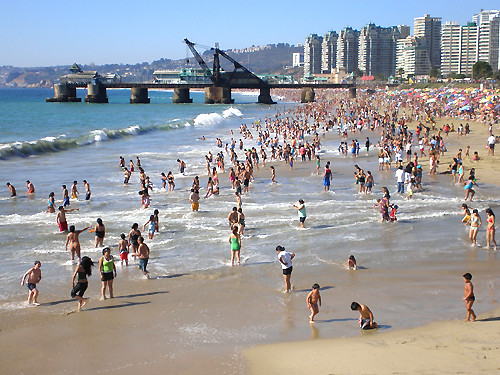
At the beach in Vina del mar, less than 10% of the people are actually getting wet. These 10% are not swimming though. They just stay on the sand, but within reach of the waves.
When we got to the beach, we thought that this was because of the cold water. The water is cold, but by no means too cold to swim. Our Chilean friends (both of whom grew up within a few miles of this beach) said that the reason was the “dangerous undertow”.
They said there was a good swimming beach about a quarter mile away. So we (Marathon and I) ran to that beach.
At this beach also, no one was in the water. We got in and started swimming. We made it past the difficult area where you are in risk of having a wave break on you, and swam out to where the waves were just big humps, a perfectly safe area. Then we heard a whistle. We looked back and saw all the people on the shore staring at us. A little bit later, it blew again. This time we saw the lifeguard too. We swam back to the shore and asked the lifeguard what was wrong with swimming at this “swimming beach”. He explained that “we’re having a little more wave action than normal”. Disappointed, we returned to the original beach, beginning to entertain some doubts about the logic for disallowing swimming.
We then swam out at this beach too, just trying to swim all we could until authority ordered us back onto the sand. After a couple minutes, a lifeguard saw us and did so.
“Dangerous currents” appears to be an idea that the local government and lifeguards have put into the minds of all the people, so they would avoid as many liabilities as possible.
The “undertow” is the harmless affect of a wave running off the beach back under the next wave. It isn’t dangerous.
What is dangerous, but easily avoidable, is the Rip-current. This is caused in a situation of two underwater sand bars with a small space between them. When a wave comes in, a lot of water is going to flow back out of this space, instead of going over the sand bars. The high-speed current that results goes way faster than anyone can swim, and can carry a person up to half a mile away from the beach. The way to avoid this is to swim parallel to the beach, as to escape the narrow current. It’s like this: the rip current is a treadmill going faster than you can run. You could drown of exhaustion trying to run against it, or you can just get off.
This is a diagram of a small rip current. The beach at Vina del Mar clearly did not have one.

So, all of this leaves us wondering: how is it that this myth could keep so many people, for so many years, from actually getting into the water when they go to the beach?
Leave a Reply